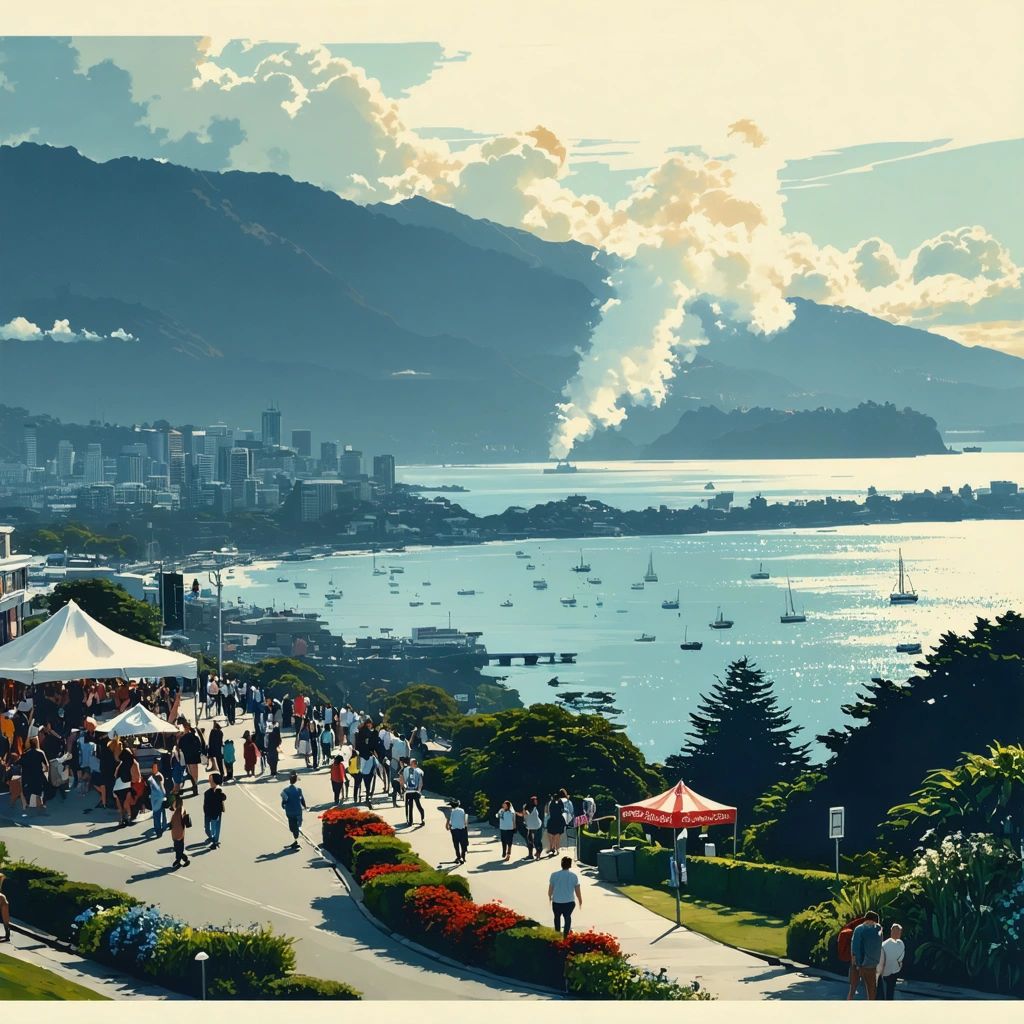When the Wind Whispers and the Rain Dances: Understanding Wellington’s Weather
Imagine waking up on a bright morning in Wellington, New Zealand’s capital city, only to find that by noon, the sky has transformed into a dramatic canvas of swirling clouds and gusty winds. If you’ve ever checked the weather Wellington forecasts, you know this city doesn’t just experience changeable weather—it thrives on it. Wellington’s climate can be as unpredictable as a plot twist in a gripping novel, shifting rapidly from sunny calm to blustery storms that seem to have a life of their own.
But why does Wellington’s weather have such a wild reputation, and what does this mean for the people who call this city home? More importantly, how has this ever-changing climate influenced Wellington’s unique cultural identity? If you’re curious about what makes this city’s atmosphere tick—both literally and figuratively—stick around. We’ll unravel the threads of Wellington’s weather story and see how it’s intertwined with the vibrant, resilient character of its residents.
More Than Just a Breeze: The Challenge of Wellington’s Weather
Let’s face it: the weather Wellington experiences can be a bit of a rollercoaster. Unlike more predictable climates, here the wind is a constant player. The city is famously dubbed the “Windy City” of New Zealand, with average wind speeds that often leave visitors clutching hats and locals embracing their trusty jackets. Even when neighboring towns like Napier enjoy the gentle warmth of their own Napier weather, Wellington can be swirling in gusts that shape everything from daily routines to architecture.
This variability presents a unique set of challenges. Outdoor events must be planned with contingency in mind, the design of homes and public spaces must withstand the elements, and local businesses—even the famous cafes—learn to adapt to sudden changes. The weather isn’t just background noise; it actively shapes life here. Those who have lived in Wellington long enough develop an intuitive radar for when the weather is about to turn, but even then, the unpredictability can catch newcomers—and even locals—off guard.
- Wind speeds frequently reach 30-40 km/h, with gusts soaring higher during storms.
- Sudden rain showers can interrupt the sunniest days, creating a patchwork of weather that keeps everyone guessing.
- Seasonal shifts are marked less by gradual changes and more by abrupt swings.
So, how does the city cope? More importantly, how does it flourish despite these climatic quirks?
From Turbulence to Tenacity: Weather as a Cultural Catalyst
Here’s the compelling twist: Wellington’s weather, wild as it is, doesn’t just challenge its people—it inspires them. The city’s dynamic climate has seeped into the very fabric of its cultural identity, influencing art, community spirit, and even the local sense of humor. Residents often joke that Wellingtonians aren’t made of sugar—they don’t melt in the rain or crumble in the wind; instead, they dance through it.
The unique blend of blustery days and brisk sunshine has fostered a community that’s resilient and adaptable. Outdoor festivals, markets, and gatherings not only persist but thrive, often featuring whimsical nods to the unpredictable weather. Artists capture the shifting skies in vibrant murals, while writers and poets draw metaphors from the ever-changing elements. Even the city’s architecture tells a story of weather-tested innovation, balancing aesthetics with the practical need to withstand gusts and showers.
When you compare the steady, more temperate Napier weather with Wellington’s tempestuous climate, the differences are stark. Napier’s predictable sunshine supports its reputation as a sunny, laid-back spot, whereas Wellington’s weather demands a certain edge—a readiness for anything, a spark of creativity born from constant change. This climatic tension permeates local culture, shaping attitudes and lifestyles in subtle but powerful ways.
What’s Next? Navigating Wellington’s Weather with Confidence
In this article, we’ll dive deeper into the fascinating relationship between Wellington’s weather and its cultural heartbeat. We’ll explore:
- How the city’s geography and location contribute to its notorious wind and weather patterns
- The impact of Wellington’s weather on daily life, from commuting to social activities
- Comparisons with other New Zealand cities like Napier to highlight Wellington’s climatic uniqueness
- Stories of resilience and creativity inspired by the environment
- Practical tips for residents and visitors alike to embrace the city’s ever-changing skies
Whether you’re a Wellington local, a visitor planning a trip, or simply fascinated by how environment shapes culture, understanding the nuances of Wellington’s weather offers a fresh lens on this remarkable city. So buckle up—this is more than just a forecast. It’s a story of a city that turns the wildness of its climate into a vibrant expression of community and identity.
Stay with us as we uncover the many ways the weather in Wellington isn’t just a backdrop but a dynamic force that molds the spirit of the city and its people.

Understanding Wellington’s Weather: NZ’s Wild Climate and Its Cultural Impact
What Makes Wellington Weather So Dynamic?
Wellington, New Zealand’s capital city, is renowned for its dynamic and often unpredictable weather patterns. Situated at the southwestern tip of the North Island, Wellington is exposed to the meeting point of the Tasman Sea and the Pacific Ocean. This unique geographic location results in a climate characterized by rapid changes, frequent strong winds, and variable temperatures.
The city experiences a temperate maritime climate with four distinct seasons, but its weather can shift dramatically within hours. The famous “Wellington weather” is influenced by:
- Strong Westerly Winds: Known locally as the “Wellington Wind,” these winds are caused by the funnelling effect of the Cook Strait and the surrounding hills, making the city one of the windiest capitals in the world.
- Oceanic Influence: Proximity to both the Tasman Sea and the Pacific Ocean introduces moist air masses that lead to frequent showers and sudden weather changes.
- Topography: The hilly terrain affects microclimates within the city, causing variations in temperature, rainfall, and wind intensity across short distances.
Because of these factors, “weather Wellington” is often described as changeable and lively, contributing to the city’s distinctive character and lifestyle.
How Does Wellington’s Weather Compare to Napier Weather?
While Wellington experiences strong winds and variable weather, Napier, located on the east coast of the North Island, has a notably different climate. Napier weather is generally more stable and warmer, classified as a Mediterranean climate with dry summers and mild winters.
Key differences between Wellington weather and Napier weather include:
- Wind Patterns: Wellington is well-known for its persistent strong winds, while Napier has lighter and less frequent wind events.
- Rainfall: Wellington receives more rainfall spread throughout the year, whereas Napier experiences drier conditions, especially in summer.
- Temperature Variation: Napier tends to have warmer average temperatures, making it a popular destination for beachgoers and outdoor activities.
Understanding these differences helps residents and visitors plan accordingly and appreciate the diversity of New Zealand’s climates.
In What Ways Does Wellington’s Wild Climate Shape Its Cultural Identity?
The ever-changing Wellington weather has a profound influence on the city’s vibrant cultural identity, impacting everything from architecture and outdoor lifestyle to festivals and local attitudes.
Some of the cultural effects include:
- Resilient and Adaptive Spirit: Wellingtonians often embrace the unpredictability of their environment, developing a reputation for being hardy, resourceful, and adaptable.
- Architectural Features: Buildings are designed to withstand strong winds, with many featuring reinforced structures and wind-resistant materials.
- Outdoor Events and Festivals: Despite the challenging weather, the city hosts numerous outdoor cultural events, such as the Wellington Sevens rugby tournament and the New Zealand Festival, showcasing the community’s enthusiasm and resilience.
- Creative Inspiration: The dramatic weather and natural surroundings have inspired artists, writers, and filmmakers, contributing to Wellington’s nickname as “the coolest little capital.”
These cultural facets demonstrate how Wellington’s climate is not just a backdrop but an integral part of the city’s identity and way of life.
What Should Visitors Know About Wellington Weather When Planning a Trip?
Visitors to Wellington should be prepared for rapidly changing conditions and strong winds year-round. Practical tips include:
- Pack layers to accommodate fluctuating temperatures and sudden weather shifts.
- Bring a sturdy windproof jacket and waterproof gear to stay comfortable during gusty and rainy days.
- Check reliable sources for the latest Wellington weather updates before outdoor activities.
- Plan indoor activities or flexible schedules to accommodate possible weather disruptions.
By understanding and respecting Wellington’s wild climate, visitors can fully enjoy the city’s rich culture and natural beauty.
How Can Locals and Businesses Adapt to Wellington’s Weather Challenges?
Adapting to the “weather Wellington” presents several challenges but also opportunities for innovation:
- Infrastructure Resilience: Implementing wind-resistant designs and materials in construction helps reduce damage and maintenance costs.
- Energy Efficiency: Utilizing the wind for renewable energy, such as wind turbines, aligns with environmental goals and leverages natural conditions.
- Community Preparedness: Public awareness campaigns and emergency planning ensure safety during extreme weather events.
- Tourism Marketing: Emphasizing the city’s unique climate and cultural response attracts visitors interested in authentic and adventurous experiences.
Such strategies highlight how Wellington’s weather challenges can be transformed into strengths that enhance the city’s sustainability and appeal.

